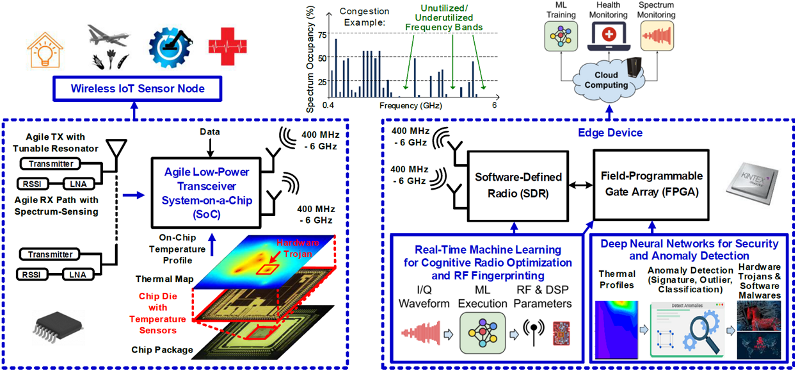
|
Acknowledgement |
|
This material is based upon work supported by the National Science Foundation under grant no. 2146754 and is supported in part by funds from OUSD R&E, NIST, and industry partners as specified in the Resilient & Intelligent NextG Systems (RINGS) program. |
|
Analog & Mixed-Signal Integrated Circuit Research Laboratory - Marvin Onabajo, Professor, Department of Electrical and Computer Engineering - Thomas Gourousis, Ph.D. Student - Junyi Yang, M.S. Student
Northeastern University Energy-Efficient and Secure Systems Lab - Yunsi Fei, Professor, Department of Electrical and Computer Engineering - Ruyi Ding, Ph.D. Student - Ziyue Zhang, Ph.D. Student - Davis Ranney, Ph.D. Student
Energy Efficient Circuits and Systems Group - Aatmesh Shrivastava, Associate Professor, Department of Electrical and Computer Engineering - Ankit Mittal, Ph.D. Student - Ryan Dailor, Undergraduate Student
- Francesco Restuccia, Assistant Professor, Department of Electrical and Computer Engineering - Milin Zhang. Ph.D. Student |


|
Internet of Things Resilience through Spectrum-Agile Circuits, |

|
Home |
|
Research |
|
Students |
|
Teaching |
|
Publications |
|
Biography |
|
Sponsors |
|
NSF RINGS Project |

|
Participating Research Groups |
|
Project Overview |

|
As the Internet of Things (IoT) continues to grow at a fast pace, the increasing number of wireless devices in the frequency spectrum up to 6 GHz creates a compelling need to securely adapt IoT communications based on availability in the wireless spectrum environment. Autonomous coordination of wireless transmissions to avoid congestions becomes particularly important when numerous IoT devices with stringent power consumption restrictions communicate with an edge device connected to the cloud; collecting information with relatively low data rates such as biomedical signals, detected gases/chemicals levels, temperature, humidity, or vibration data. Such low-power IoT device applications include medical and health care, smart homes, transportation, manufacturing, agriculture, and environmental monitoring. It is imperative to design IoT networks with resilience features deeply embedded across layers from the integrated circuit level to the wireless system level. When IoT devices are employed with sensors in increasingly crowded environments to transmit sensed information, it is essential to increase their awareness of incumbent spectrum users and avoid interference. An overarching goal of this project is to create spectrum-agile IoT networks with low-power adaptive radio frequency (RF) circuits at the sensor nodes, and with coordinated optimization and enhanced security at the edge device. The synergies between the circuits, computing, and wireless networking components of this research are anticipated to create a paradigm for resilient next-generation IoT networks with energy-efficient secure communication between sensor nodes and edge devices. Research and education will be integrated by incorporating the obtained knowledge into graduate and undergraduate education. In addition, high school interns will be engaged through the Center for STEM Education at Northeastern University.
The project entails the research and development of a coordinated cross-layer design methodology for agile communication between edge devices and IoT sensor nodes. This is achieved by distributing spectrum sensing and real-time reconfiguration as follows: fast coarse spectrum sensing and reconfiguration in the sub-6 GHz frequency range on the analog/RF circuit level within low-power IoT devices, fine carrier sensing and network level optimizations on the edge device, and enhancement of high-level authentication and anomaly detection with the computing capabilities on the edge device; all aided by wirelessly transmitted information from temperature sensors used as activity detectors embedded in the IoT device transceiver. This cross-layer approach aims at enabling adaptive edge networks by providing the device-level ability to quickly respond to disruptive interference events by changing the transmit and receive frequencies at the IoT nodes, while performing intelligent real-time machine learning (ML) functions for coordinated communication within the network on the edge device with a software-defined radio (SDR) and field-programmable gate array (FPGA). Security will be enhanced at the wireless system level through ML-based RF fingerprinting, while robustness will be enhanced through federated learning techniques. At the hardware level, security will be enhanced through monitoring of power dissipation via embedded temperature sensors. The cross-cutting approach is not only expected to increase the component-level trust that can be established when new IoT devices are introduced into the network, but also to improve run-time reliability by capturing abnormal operations due to malicious intrusions or hardware faults based on the wirelessly transmitted on-chip temperature profiles from the IoT devices. |